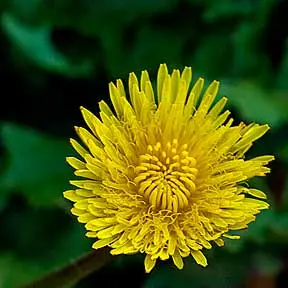The healing ways of dandelion spread as quickly as its seeds parachute in the wind. The Chinese were the first to describe dandelion’s medicinal virtues in purifying the blood and increasing the immune system. By the eleventh century, Arabic cultures were sharing its use to treat troubles of the liver and kidneys. Soon all of Europe was using dandelion in their kitchens and storing it in their medicine cabinets.
Dandelion were called “fairy clocks” because their flowers open and close predictably.
Dandelion was used as a tool for divination. If you blow a seed head, the number of seeds remaining are the number of children you will have.
In Victorian Flower language, Dandelion symbolizes Love. It has also symbolized wishes, welcome, faithfulness and divination, grief and bitterness, and the sun.
Dandelion Magic

Dandelion is more than an adapter; Dandelion is a transformer. Loosening compacted soil by growing deep roots, creating a micro-climate that draws earthworms, who’s job it is to change and rejuvenate the soil, drawing nutrients and toxins to the surface for use and transformation, dandelion is symbolic of the kind of magic that gently and firmly changes those conditions that no longer serve its environment. Dandelion magic is the magic of practical, gentle, and intentional transformation.
Dandelion’s bright yellow flowers open with the morning with the sun’s first light and close again in the evening, giving it a strong sun affinity. Dandelion is one of the first to flower in spring and one of the last to go dormant in the winter. It prefers cooler weather, flowering more profusely in the spring and fall than in the summer. All of this speaks to Dandelion’s sensitivity. Dandelion asks us to be equally aware of the conditions under which we can best use the power we have.
Dandelion seeds germinate quickly, generally taking from three to six weeks to sprout, and are able to survive a light frost. It is an aid in activating compost as well, making Dandelion a useful agent for getting transformative energies moving quickly and keeping those energies moving despite minor set-backs.
Finally, Dandelion is an aid to its community, transforming its environment so more delicate plants can grow, providing a wealth of nutrients to a wide array of herbivores and omnivores, and providing bees and other insects with nectar when other plants cannot bloom. It is a plant who asks us to share our energies and ourselves with our communities in an effort to nourish the world.
In astrology, Dandelion is considered a masculine plant and is governed by Jupiter and the Sun. In Ayurvedic medicine, it’s associated with Saturn. Dandelion’s element is Air.
To learn more about dandelion, read The Practical Herbalist’s Herbal Encyclopedia entry on this herb or buy The Practical Herbalist’s Herbal Folio: Dandelion: Herbal Medicine Rooted in Your Front Yard.






